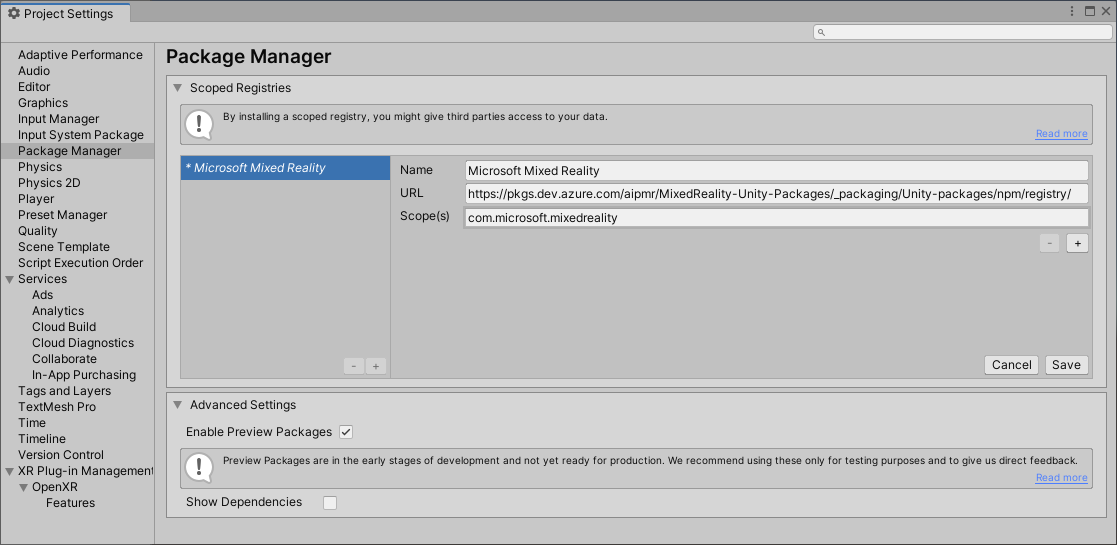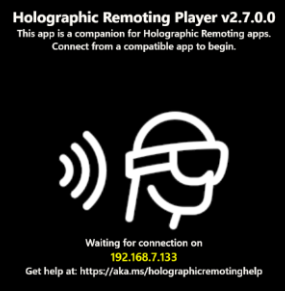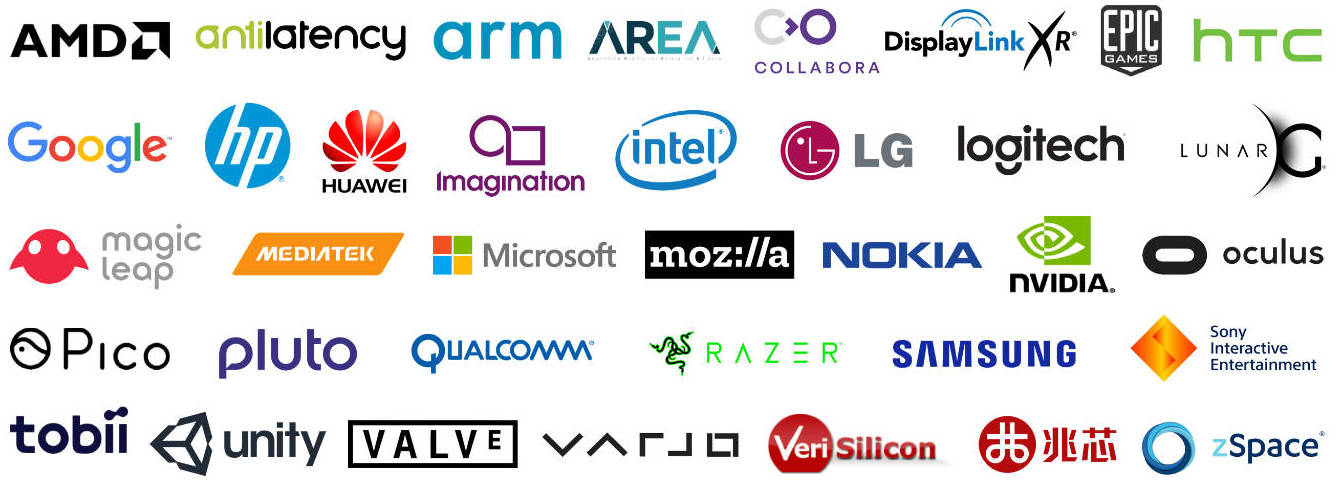- OpenXR Support for Oculus Unity Integration OpenXR, the industry-backed standard that aims to streamline the development of XR applications, has made several major steps this year toward becoming.
- Furthermore, by enabling OpenXR support on partner platforms, it affords Unity the ability to make support widely available for other OpenXR runtimes/devices. Early next year, the company plans to release an experimental version of Unity OpenXR that works with other conformant OpenXR runtimes based on the OpenXR 1.0 specification.
OpenXR is an extensible API that can be extended with new features. To facilitate this within the Unity ecosystem, the Unity OpenXR provider offers a feature extension mechanism.
The Mixed Reality OpenXR Plugin package is an extension of Unity's OpenXR Plugin and supports a suite of features for HoloLens 2 and Windows Mixed Reality headsets. Before continuing, make sure your Unity project is configured for OpenXR.
Feature management window


Note: The configuration of this window might change in the future.
You can manage features from the Project Settings > XR Plug-in Management > OpenXR > Features window.
To enable or disable a feature, select or clear the checkbox next to it. Unity doesn't execute disabled features at runtime, and does't deploy any of the feature's native libraries with the Player build. To configure additional build-time properties specific to each feature, click the arrow under a feature to expand the additional settings foldout.
All of the information in this window is populated via the OpenXRFeatureAttribute described below.
Feature sets group a number of different features together to allow you to configure them simultaneously, which might offer a better development experience. For more information, see the Defining a feature set section on this page.
Defining a feature
Unity OpenXR features are defined and executed in C#. C# can call to a custom native plugin if desired. The feature can live somewhere in the user's project or in a package, and it can include any Assets that a normal Unity project would use.
A feature must override the OpenXRFeature ScriptableObject class. There are several methods that you can override on the OpenXRFeature class in order to do things like intercepting native OpenXR calls, obtaining the xrInstance and xrSession handles, starting Unity subsystems, etc.
A feature can add public fields for user configuration at build time. Unity renders these fields via a PropertyDrawer in the feature UI, and you can override them. Your feature can access any of the set values at runtime.
A feature must also provide an OpenXRFeature attribute when running in the Editor.

Unity uses this information at build time, either to build the Player or to display it to the user in the UI.
Defining a feature set
Unity OpenXR allows you to define a feature set you can use to enable or disable a group of features at the same time. This way, you don't need to access the Feature section in Project Settings > XR Plug-in Management > OpenXR window to enable or disable features.
Declare a feature set through the definition of one or more OpenXRFeatureSetAttribute declarations in your code. You can place the attribute anywhere because the feature set functionality only depends on the attribute existing and not on the actual class it's declared on.

You can configure feature sets in the XR Plug-in Management plug-in selection window. When you select the OpenXR plug-in from this window, the section under the plug-in displays the sets of features available. Not all feature sets are configurable. Some require you to install third-party definitions. The window displays information on where to get the required packages if needed.
Enabling OpenXR spec extension strings
Unity will attempt to enable any extension strings listed in OpenXRFeatureAttribute.OpenxrExtensionStrings (separated via spaces) on startup. Your feature can check the enabled extensions in order to see if the requested extension was enabled (via OpenXRRuntime.IsExtensionEnabled).
OpenXRFeature call order
The OpenXRFeature class has a number of methods that your method can override. Implement overrides to get called at specific points in the OpenXR application lifecycle.
Bootstrapping
HookGetInstanceProcAddr
This is the first callback invoked, giving your feature the ability to hook native OpenXR functions.
Initialize
OnInstanceCreate => OnSystemChange => OnSubsystemCreate => OnSessionCreate
The initialize sequence allows features to initialize Unity subsystems in the Loader callbacks and execute them when specific OpenXR resources are created or queried.
Start
OnSessionBegin => OnFormFactorChange => OnEnvironmentBlendModeChange => OnViewConfigurationTypeChange => OnAppSpaceChange => OnSubsystemStart
The Start sequence allows features to start Unity subsystems in the Loader callbacks and execute them when the session is created.
Gameloop
Several: OnSessionStateChange
OnSessionBegin
Maybe: OnSessionEnd
Callbacks during the gameloop can react to session state changes.
Stop
OnSubsystemStop => OnSessionEnd
Shutdown
OnSessionExiting => OnSubsystemDestroy => OnAppSpaceChange => OnSessionDestroy => OnInstanceDestroy

Build Time Processing
A feature can inject some logic into the Unity build process in order to do things like modify the manifest.
Typically, you can do this by implementing the following interfaces:
IPreprocessBuildWithReportIPostprocessBuildWithReportIPostGenerateGradleAndroidProject
Features should not implement these classes, but should instead implement OpenXRFeatureBuildHooks, which only provide callbacks when the feature is enabled. For more information, see OpenXRFeatureBuildHooks.
Build time validation
If your feature has project setup requirements or suggestions that require user acceptance, implement GetValidationChecks. Features can add to a list of validation rules which Unity evaluates at build time. If any validation rule fails, Unity displays a dialogue asking you to fix the error before proceeding. Unity can also presents warning through the same mechanism. It's important to note which build target the rules apply to.
Example:
Custom Loader library
One and only one Unity OpenXR feature per BuildTarget canhave a custom loader library. This must be named openxr_loader with native platform naming conventions (for example, libopenxr_loader.so on Android).
Features with a custom loader library must set the OpenXRFeatureAttribute: CustomRuntimeLoaderBuildTargets to a list of BuildTargets in which a custom loader library is expected to be used. Features that do not use a custom loader library do not have to set CustomRuntimeLoaderBuildTargets (or can set it to null or an empty list).
Openxr Download
The custom loader library must be placed in the same directory or a subdirectory of the C# script that extends the OpenXRFeature class. When the feature is enabled, Unity will include the custom loader library in the build for the active BuildTarget, instead of the default loader library for that target.
Feature native libraries
Any native libraries included in the same directory or a subdirectory of your feature will only be included in the built Player if your feature is enabled.
Feature use cases
Unity Openxr Steam
Intercepting OpenXR function calls
Unity Openxr Haptic
To intercept OpenXR function calls, override OpenXRFeature.xrGetInstanceProcAddr. Returning a different function pointer allows intercepting any OpenXR method. For an example, see InterceptCreateSessionExt.
Hololens Unity Openxr
Providing a Unity subsystem implementation
OpenXRFeature provides several XR Loader callbacks where you can manage the lifecycle of Unity subsystems. For an example meshing subsystem feature, see the MeshingTeapotExt example (and the package sample that corresponds with it).
Unity Openxr Support
Note that a UnitySubsystemsManifest.json file is required in order for Unity to discover any subsystems you define. At the moment, there are several restrictions around this file:
- It must be only 1 subfolder deep in the project or package.
- The native library it refers to must be only 1-2 subfolders deeper than the
UnitySubsystemsManfiest.jsonfile.
